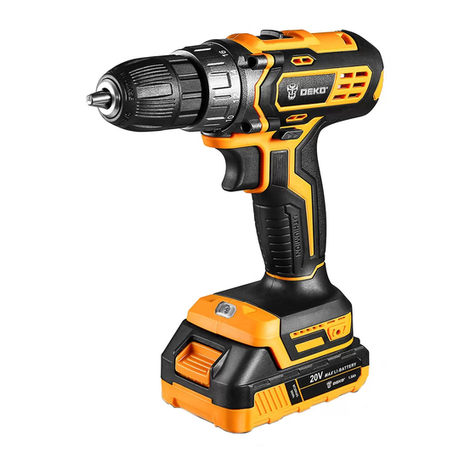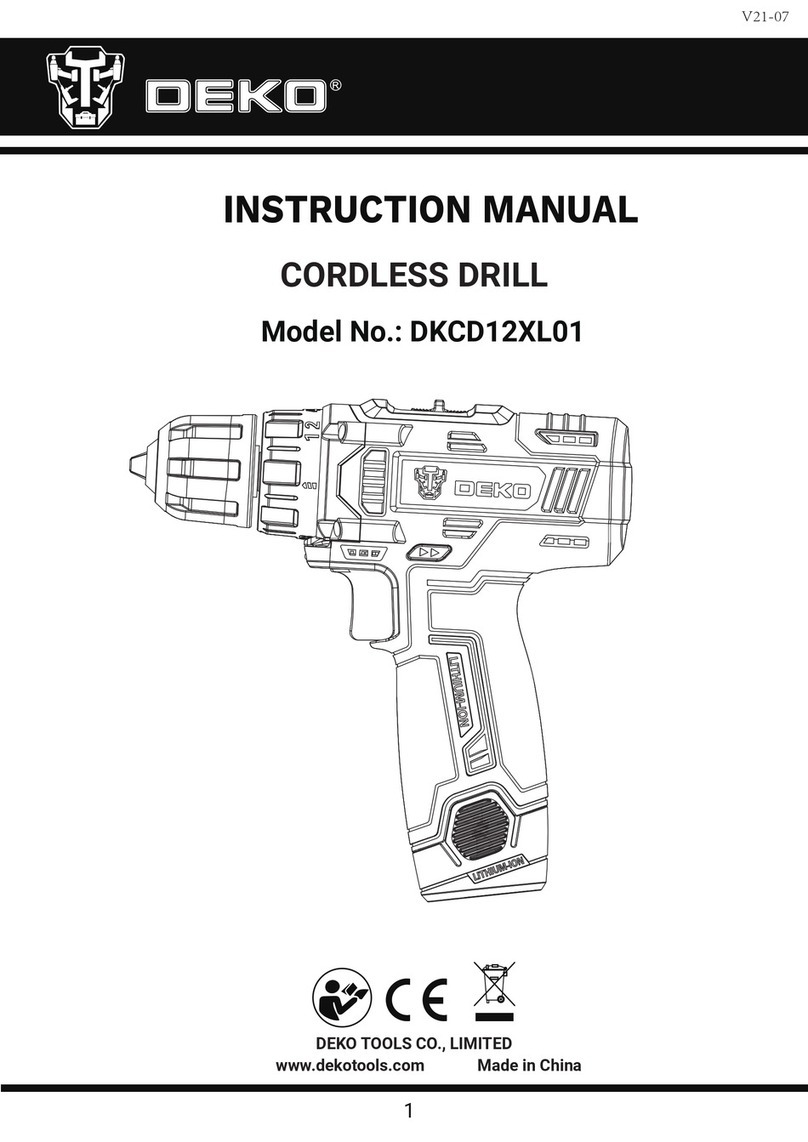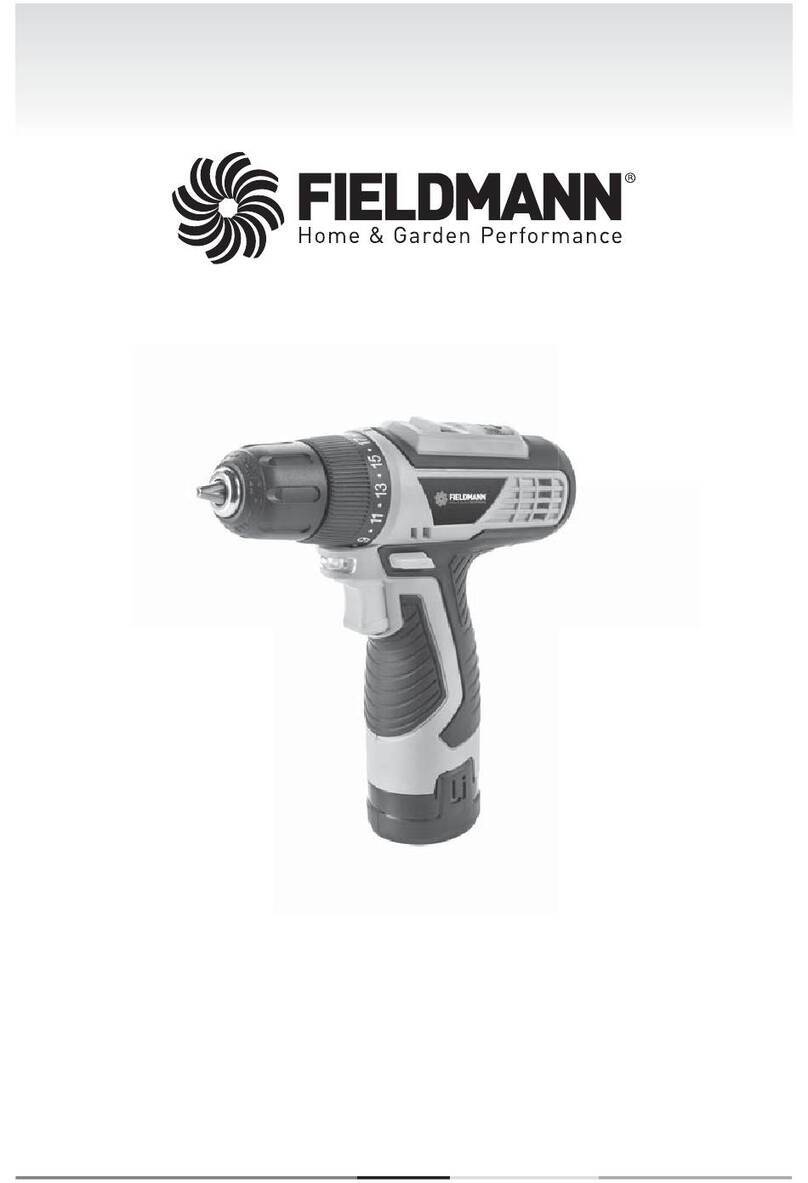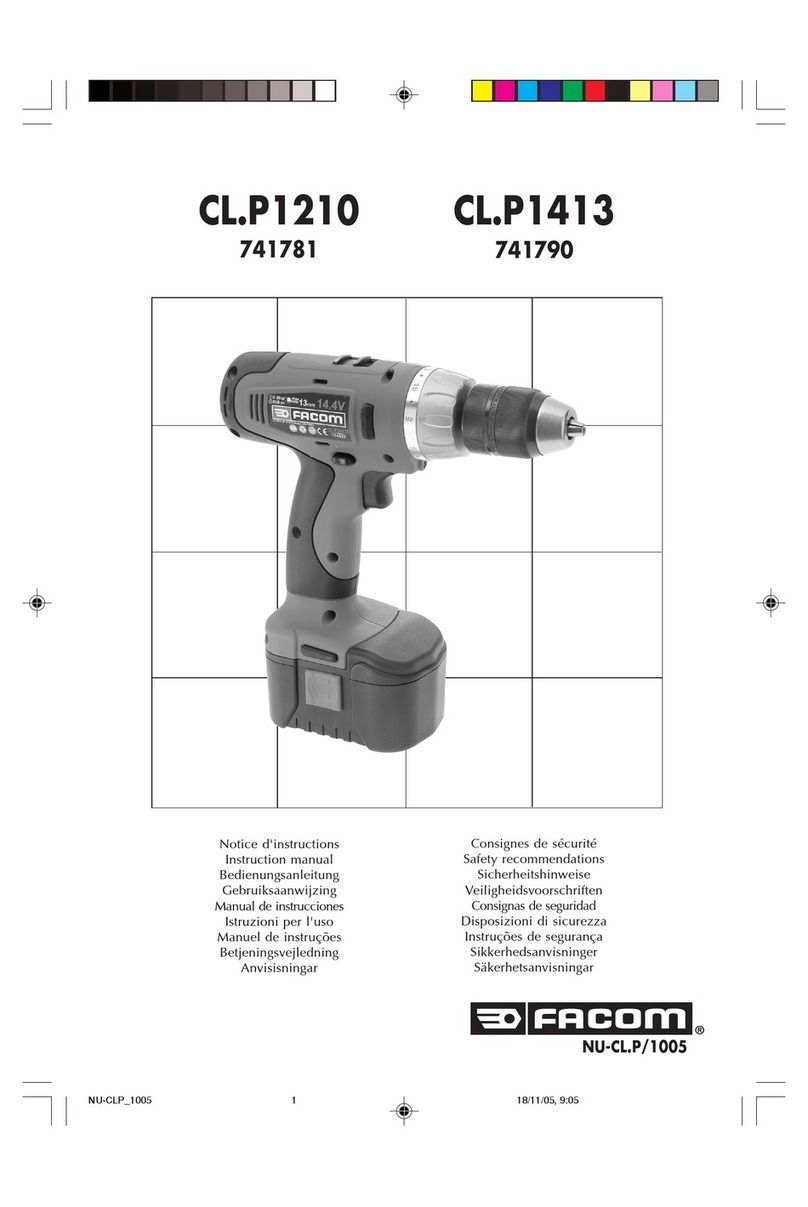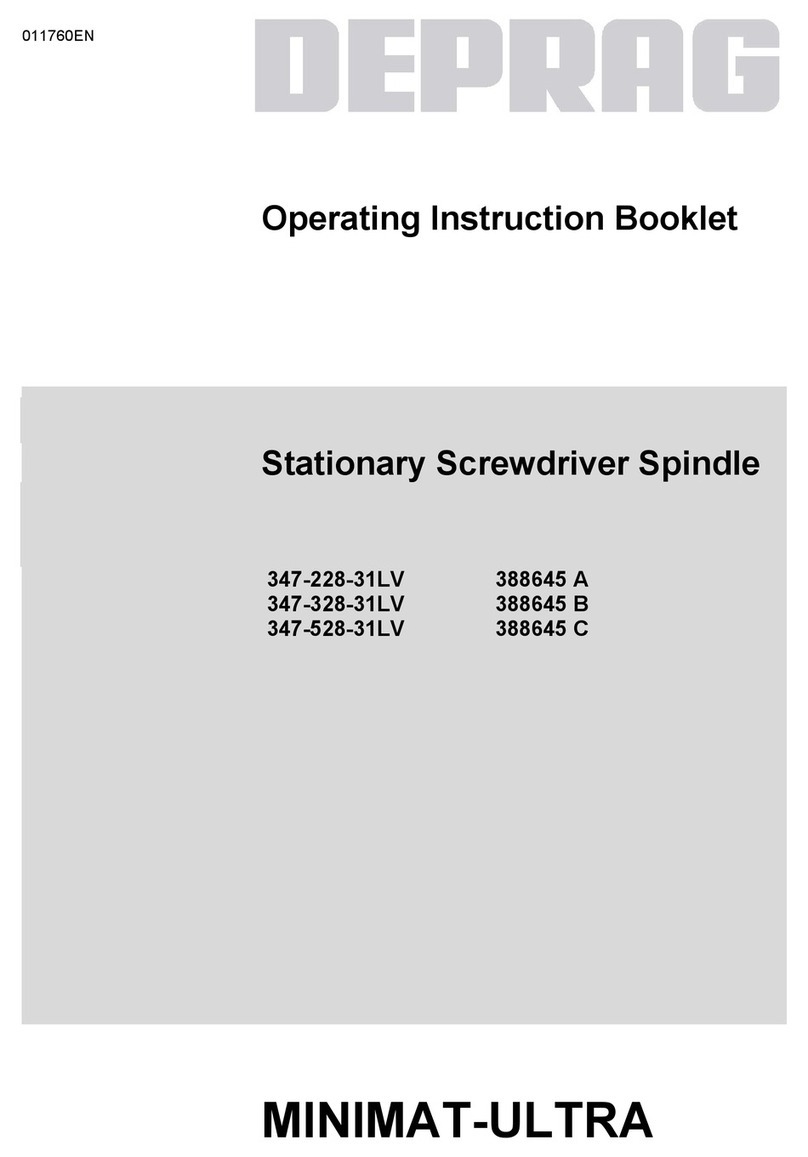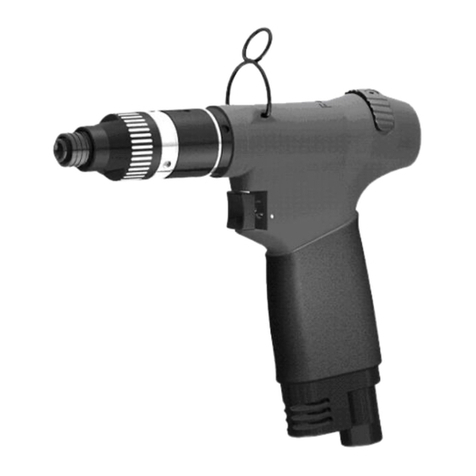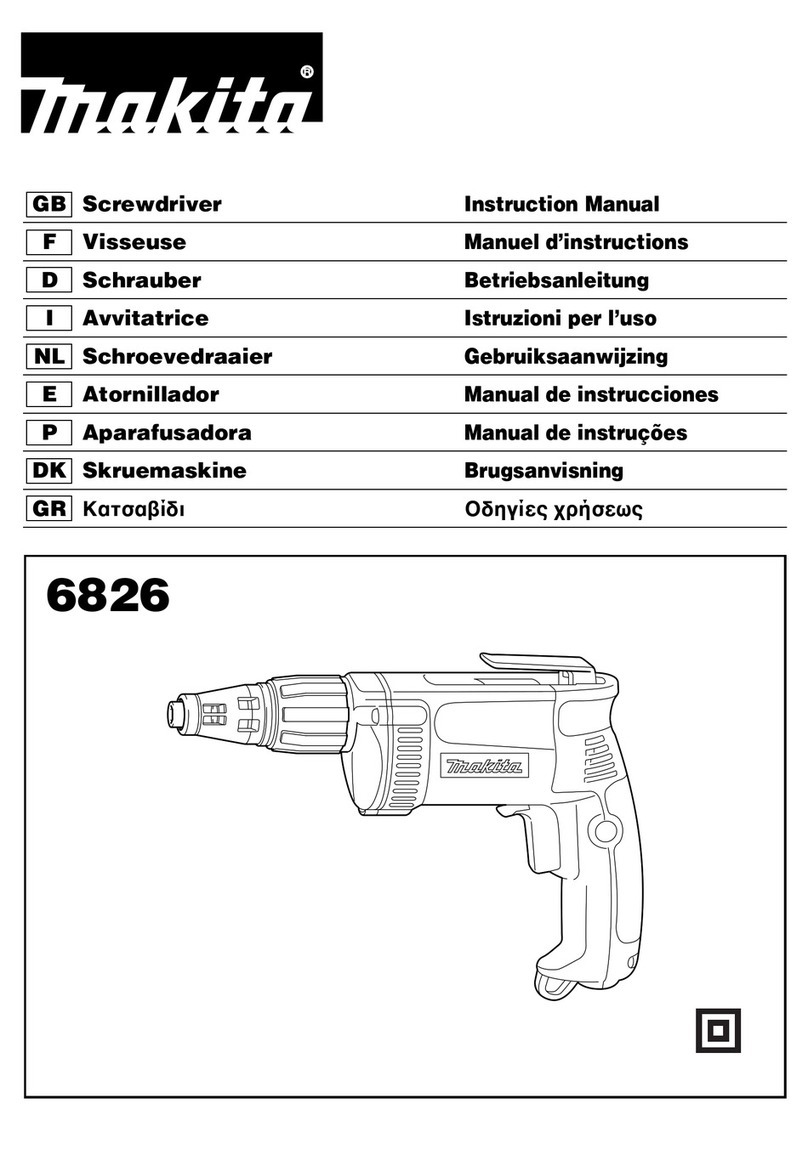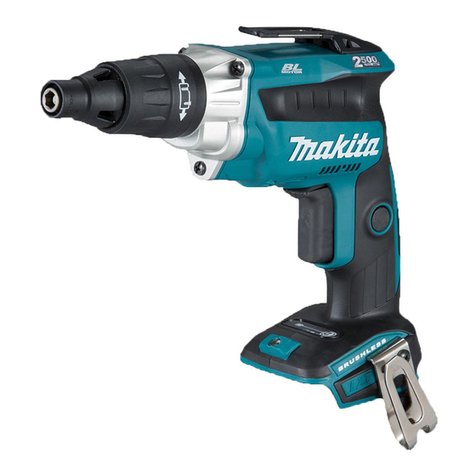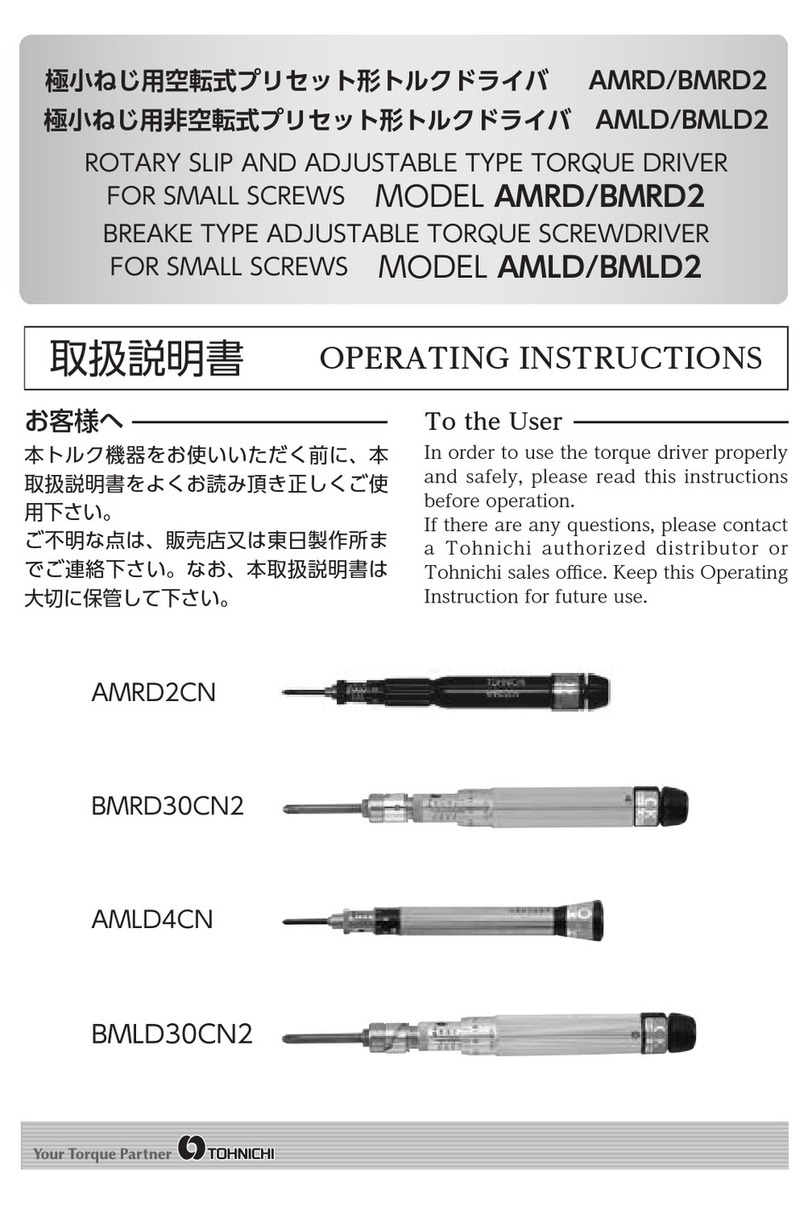DeKo DKCS3.6O1 User manual

1
General Power Tool Safety Warnings
⚠WARNING: Read all safety warnings, instructions, illustrations and specifications provided with this power tool.
Failure to follow all instructions listed below may result in electric shock, fire and/or serious injury.
Save all warnings and instructions for future reference.
The term "power tool" in the warnings refers to your mains-operated (corded) power tool or battery-operated
(cordless) power tool.
1) Work area safety
a) Keep work area clean and well lit. Cluttered or dark areas invite accidents.
b) Do not operate power tools in explosive atmospheres, such as in the presence of flammable liquids, gases or
dust. Power tools create sparks which may ignite the dust or fumes.
c) Keep children and bystanders away while operating a power tool. Distractions can cause you to lose control.
2) Electrical safety
a) Power tool plugs must match the outlet. Never modify the plug in any way. Do not use any adapter plugs with
earthed (grounded) power tools. Unmodified plugs and matching outlets will reduce risk of electric shock.
b) Avoid body contact with earthed or grounded surfaces, such as pipes, radiators, ranges and refrigerators.
There is an increased risk of electric shock if your body is earthed or grounded.
c) Do not expose power tools to rain or wet conditions. Water entering a power tool will increase the risk of electric
shock.
d) Do not abuse the cord. Never use the cord for carrying, pulling or unplugging the power tool. Keep cord away
from heat, oil, sharp edges or moving parts. Damaged or entangled cords increase the risk of electric shock.
e) When operating a power tool outdoors, use an extension cord suitable for outdoor use. Use of a cord suitable
for outdoor use reduces the risk of electric shock.
f) If operating a power tool in a damp location is unavoidable, use a residual current device (RCD) protected
supply. Use of an RCD reduces the risk of electric shock.
3) Personal safety
a) Stay alert, watch what you are doing and use common sense when operating a power tool. Do not use a power
tool while you are tired or under the influence of drugs, alcohol or medication. A moment of inattention while
operating power tools may result in serious personal injury.
b) Use personal protective equipment. Always wear eye protection. Protective equipment such as a dust mask,
non-skid safety shoes, hard hat or hearing protection used for appropriate conditions will reduce personal injuries.
c) Prevent unintentional starting. Ensure the switch is in the off-position before connecting to power source
and/or battery pack, picking up or carrying the tool. Carrying power tools with your finger on the switch or
energising power tools that have the switch on invites accidents.
d) Remove any adjusting key or wrench before turning the power tool on. A wrench or a key left attached to a
rotating part of the power tool may result in personal injury.
e) Do not overreach. Keep proper footing and balance at all times. This enables better control of the power tool in
unexpected situations.
f) Dress properly. Do not wear loose clothing or jewellery. Keep your hair and clothing away from moving parts.
Loose clothes, jewellery or long hair can be caught in moving parts.
g) If devices are provided for the connection of dust extraction and collection facilities, ensure these are
connected and properly used. Use of dust collection can reduce dust-related hazards.
h) Do not let familiarity gained from frequent use of tools allow you to become complacent and ignore tool safety
principles. A careless action can cause severe injury within a fraction of a second.
4) Power tool use and care
a) Do not force the power tool. Use the correct power tool for your application.The correct power tool will do the
job better and safer at the rate for which it was designed.
b) Do not use the power tool if the switch does not turn it on and off. Any power tool that cannot be controlled with
the switch is dangerous and must be repaired.
c) Disconnect the plug from the power source and/or remove the battery pack, if detachable, from the power tool
before making any adjustments, changing accessories, or storing power tools. Such preventive safety measures
reduce the risk of starting the power tool accidentally.
d) Store idle power tools out of the reach of children and do not allow persons unfamiliar with the power tool or
these instructions to operate the power tool. Power tools are dangerous in the hands of untrained users.
e) Maintain power tools and accessories. Check for misalignment or binding of moving parts, breakage of parts
and any other condition that may affect the power tool’s operation. If damaged, have the power tool repaired
before use. Many accidents are caused by poorly maintained power tools.
f) Keep cutting tools sharp and clean. Properly maintained cutting tools with sharp cutting edges are less likely to
bind and are easier to control.

2
g) Use the power tool, accessories and tool bits etc. in accordance with these instructions, taking into account
the working conditions and the work to be performed. Use of the power tool for operations different from those
intended could result in a hazardous situation.
h) Keep handles and grasping surfaces dry, clean and free from oil and grease. Slippery handles and grasping
surfaces do not allow for safe handling and control of the tool in unexpected situations.
5) Battery tool use and care.
a) Recharge only with the charger specified by the manufacturer. A charger that is suitable for one type of battery
pack may create a risk of fire when used with another battery pack.
b) Use power tools only with specifically designated battery packs. Use of any other battery packs may create a
risk of injury and fire.
c) When battery pack is not in use, keep it away from other metal objects, like paper clips, coins, keys, nails,
screws or other small metal objects, that can make a connection from one terminal to another. Shorting the
battery terminals together may cause burns or a fire.
d) Under abusive conditions, liquid may be ejected from the battery; avoid contact. If contact accidentally occurs,
flush with water. If liquid contacts eyes, additionally seek medical help. Liquid ejected from the battery may cause
irritation or burns.
e) Do not use a battery pack or tool that is damaged or modified. Damaged or modified batteries may exhibit
unpredictable behaviour resulting in fire, explosion or risk of injury.
f) Do not expose a battery pack or tool to fire or excessive temperature .Exposure to fire or temperature above
40 °C may cause explosion.
g) Follow all charging instructions and do not charge the battery pack or tool outside the temperature range
specified in the instructions. Charging improperly or at temperatures outside the specified range may damage the
battery and increase the risk of fire.
6) Service
a) Have your power tool serviced by a qualified repair person using only identical replacement parts.This will
ensure that the safety of the power tool is maintained.
b) Never service damaged battery packs. Service of battery packs should only be performed by the manufacturer or
authorized service providers.
Specific Safety Rules for The Screwdriver
⚠WARNING: Do not let comfort or familiarity with the product replace strict adherence to product safety rules.
Failure to follow the safety instructions may result in serious personal injury.
1. Personal safety.
• Always wear eye protection and a dust mask.
• DO NOT wear loose clothing or jewelry, as they might get drawn in by the tool. Tie back long hair.
• DO NOT wear gloves while operating this tool.
2.TOOL & ACCESSORIES INSPECTION. Before operation, check the tool and accessories for any damage or missing
parts. Do not use the tool if any part is missing or damaged. Make sure all adjustments are correct and all
connections are tight. Keep all guards in place.
3.Screwdriver ACCESSORIES.
• Do not use bits or any accessories that are damaged or worn.
• Make sure the bit is securely locked in the chuck.
• Always turn off the unit before doing any cleaning or maintenance.
• Do not use the charging cable if it is damaged.
4.WORKPIECE REQUIREMENTS. Check the workpiece carefully for splits, knots, nails, or other obstructions. These
types of blemishes may cause a safety risk during operation.
5.Hold the screwdriver only by the insulated gripping surfaces during operation. Fasteners that contact hidden
wiring may make the exposed metal parts of the power tool “live” and could electrically shock the operator.
6.Be sure you always have a firm footing and hold the tool firmly. Keep hands, hair and other beloved body parts
away from the rotating components of the tool.
7.Always secure the workpiece, especially if the workpiece is small.
8.Use the appropriate bits suitable for the material and the operating speed.
9.Do not touch the bit or the workpiece immediately after operation. They may be hot and could burn your skin.
10.Always remove the machine from the charger immediately after re-charging is completed.
11.Do not try to open or disassemble your screwdriver. Do not open and replace the battery cells.
Battery/Charger
⚠WARNING: Before using battery charger, read all instructions and cautionary markings on battery charger,
battery pack, and product using battery.

3
1).Do not disassemble charger or operate the charger if it has received a sharp blow, been dropped or otherwise
damaged in any way. Replace damaged cord or plugs immediately. Incorrect reassembly or damage may result in
electric shock or fire.
2).Do not recharge battery in damp or wet environment. Do not expose charger to rain or snow. If battery case is
cracked or otherwise damaged, do not insert into charger. Battery short or fire may result.
Charge only DEKO approved rechargeable batteries. See Specifications. Other types of batteries may burst causing
personal injury and damage.
3).Charge battery pack in temperatures above +50 degrees F (10 degrees C) and below +104 degrees F (40
degrees C). Store tool and battery pack in locations where temperatures will not exceed 120 degrees F (49
degrees C). This is important to prevent serious damage to the battery cells.
4).Battery leakage may occur under extreme usage or temperature conditions. Avoid contact with skin and eyes.
The battery liquid is caustic and could cause chemical burns to tissues. If liquid comes in contact with skin, wash
quickly with soap and water. If the liquid contacts your eyes, flush them with water for a minimum of 10 minutes and
seek medical attention.
5).Place charger on flat non-flammable surfaces and away from flammable materials when re-charging battery
pack. The charger and battery pack heat during charging. Carpeting and other heat insulating surfaces block proper
air circulation which may cause overheating of the charger and battery pack. If smoke or melting of the case are
observed unplug the charger immediately and do not use the battery pack or charger.
6). The battery is integrated into the tool. Do not attempt to remove the battery from the tool.
7). DO NOT PUT BATTERIES INTO FIRE OR EXPOSE TO HIGH HEAT. They may explode.
Symbols Explanation
Symbols Explanation in the Manual and/or on the Screwdriver and Battery.
Denotes risk of personal injury or damage to the tool.
Read instruction manual before use.
Conforms to relevant legislation and safety standards.
It’s environmental friendly and could be recycled.
Wear eye protection.
Wear breathing apparatus.
Keep the battery away from the fire.
Charging temperature do not exceed 40°C.
Keep the battery away from moisture or water.

4
Do not dispose of power tools and batteries/rechargeable batteries into
household waste!
Dispose the products according to the regulation and requirement of local
council.
Specifications
Voltage
3.6V⎓
Max. torque
3 N.m
No-load Speed
220/min (RPM)
Chuck
1/4 in. (6.35mm) Hex
Battery
Lithium-ion battery, 1300mAh
Charging voltage
5V ⎓(Max.) ( Charger not
included in this kit)
Parts Description
1.1/4” Magnetic chuck
2.LED worklight
3.Conversion lock
4.Direction & safety switch
5.Trigger switch
6.Battery charging indicator light
7.Charging port
8.Micro-USB charging cable
Intended Use
This screwdriver is designed to fasten and remove screws from wood, plastic, and light-gauge metal. Hex bits with
a straight shank of a diameter of 1/4” (6.35mm) can be used. Using the machine for any other purpose for which it
is not designed may result in serious injuries, machine damage and voiding of the warranty.
Operation
Charging the Tool
This tool is supplied with a Micro-USB charging cable. You can connect it with a universal
charger(output 5V⎓Max.) or USB output into charging port (7) to charge the tool.
The battery charging indicator light (6) on the screwdriver indicates the battery’s charging
status. If the light is red, the battery is being charged. If the light turns off, the battery is
finished charging

5
Installing and Removing Bits
⚠WARNING: Before installing bits, please lock the trigger switch by
placing the direction and safety switch in the center position. Do not
engage the trigger when changing bits.
1. Insert the bit into the chuck until it snaps into place.
2.To remove a screwdriver bit, lock the trigger switch by placing the
direction and safety switch in the center position and pull the bit out.
Locking the Power Switch
Before installing bits or making any adjustments, make sure to lock the trigger switch in
the center position to prevent accidental starting.
1. To lock the power switch, place the direction and safety switch (4) in the center
position.
2. Check that the screwdriver does not turn on when the trigger switch is pressed.
Changing the Direction
The direction and safety switch also determines the direction of the chuck
rotation.
⚠WARNING: Never change the direction of rotation while the trigger is
pressed down. Release the switch and wait for the chuck to stop first.
1. For clockwise rotation, push the switch to the right.
2. For counterclockwise rotation, push the switch to the left.
Switching On and Off
1.To turn on the screwdriver, use the direction and safety switch to choose the
direction of rotation, then press down on the trigger switch (5).
2.Stop the tool by releasing the trigger switch (5).
⚠WARNING: Do not touch the bit during or immediately after operation. Always
wait for the bit to stop and cool down.
LED Worklight
The LED worklight (7), located on the front of the screwdriver underneath the
chuck, illuminates workpieces while the screwdriver is running.
⚠WARNING: Do not stare into the LED beam.

6
Rotating the Handle Position
⚠WARNING: Before rotating the handle, make sure to lock the power switch to prevent accidental starting.
You can use the screwdriver in a pistol-grip or standard position, depending on what better suits the task at hand.
Push the conversion button and then rotate the upper portion of the screwdriver until it is twisted in place.
To change to rod position, press and hold the conversion button (3) and rotate the handle clockwise at the same
time until it locks in place.
To change to pistol position, press and hold the conversion button (3) and rotate the handle anti-clockwise at the
same time until it locks in place.
Pistol position
Rod position
General operation
Check the product as well as accessories for damage before each use. Do not use the product if it is damaged
or shows wear.
Double check that the accessories and attachments are properly fixed.
Always hold the product on its handle. Keep the handle dry to ensure safe support.
Switch the product off immediately if you are disturbed while working by other people entering the working
area. Always let the product come to complete stop before putting it down.
Do not overwork yourself. Take regular breaks to ensure you can concentrate on the work and have full control
over the product.
Where possible, secure smaller workpieces to prevent them from moving during operation.
Screw driving
Pre-drill the holes with a smaller diameter of the screw to be screwed.
Hold the product perpendicular to the screw to be screwed in/out. Holding it at an angle may cause slipping or
jamming of the driver bit.
Place the tip of the driver bit directly on the screw first and then switch the product on.
Only apply as much pressure as necessary to keep the screw in place and the driver bit in contact with the
screw head. Too much pressure will cause damage to the screw head and driver bit, too little pressure will
cause the driver bit to slide away.
Remove blocked and stuck screws by changing the rotational direction.
After use
Switch the product off and let it cool down.
Check, clean and store the product as described below.
Cleaning and Maintenance
⚠WARNING: Always pull out the mains power plug before starting any cleaning work.
Cleaning
1) Keep all safety devices, air vents and the motor housing free of dirt and dust as far as possible. Wipe the
equipment with a clean cloth or blow it with compressed air at low pressure.

7
2) We recommend that you clean the device immediately each time you have finished using it.
3) Clean the equipment regularly with a moist cloth and some soft soap. Do not use cleaning agents or solvents;
these could attack the plastic parts of the equipment. Ensure that no water can seep into the device.
Maintenance
There are no parts inside the equipment, which require additional maintenance.
Storage
Always store your power tool in a dry place, frost-free location. To protect the battery from damage, do not expose
the tool to temperatures above 104°F (40°C).
Service Information
This tool is warranted to the original purchaser to be free from defect in materials and workmanship for a period of
2 years from the original purchase date.
If the tool should fail some day in spite of our quality controls and materials, only have it repaired by an authorized
electrician or contact your local distributor or service agent.
Or you can contact us by emails:
services@dekotools.com, support@dekotools.com
The warranty will not apply to the following cases:
(i) where this product has been subjected to misuse, abuse, accident or want of care;
(ii) where this product has been used for a purpose for which it was not designed or is not suited;
(iii) where the service of this product has been undertaken by a non-authorised person or company or if
non-approved parts have been used.
(iv) components that are subject to natural wear and tear caused by use in accordance with operating instructions.
Transport
The contained lithium-ion batteries are subject to the Dangerous Goods Legislation requirements. The user can
transport the batteries by road without further requirements. Dispatch batteries only when the housing is
undamaged. When being transported by third parties (e.g.: air transport or forwarding agency), special
requirements on packaging and labelling must be observed. For preparation of the item being shipped, please
observe possibly more detailed national regulations and consult an expert for hazardous material.
Disposal
The machine, rechargeable batteries, accessories, and packaging should be sorted for
environmental-friendly recycling. Do not dispose of power tools and batteries/rechargeable batteries into
household waste! Please recycle them at collection points provided for the purpose. Ask your local
authority for information about recycling.

DEKO TOOLS CO., LIMITED
www.dekotools.com
Made in China
This manual suits for next models
2
Table of contents
Other DeKo Power Screwdriver manuals
Popular Power Screwdriver manuals by other brands
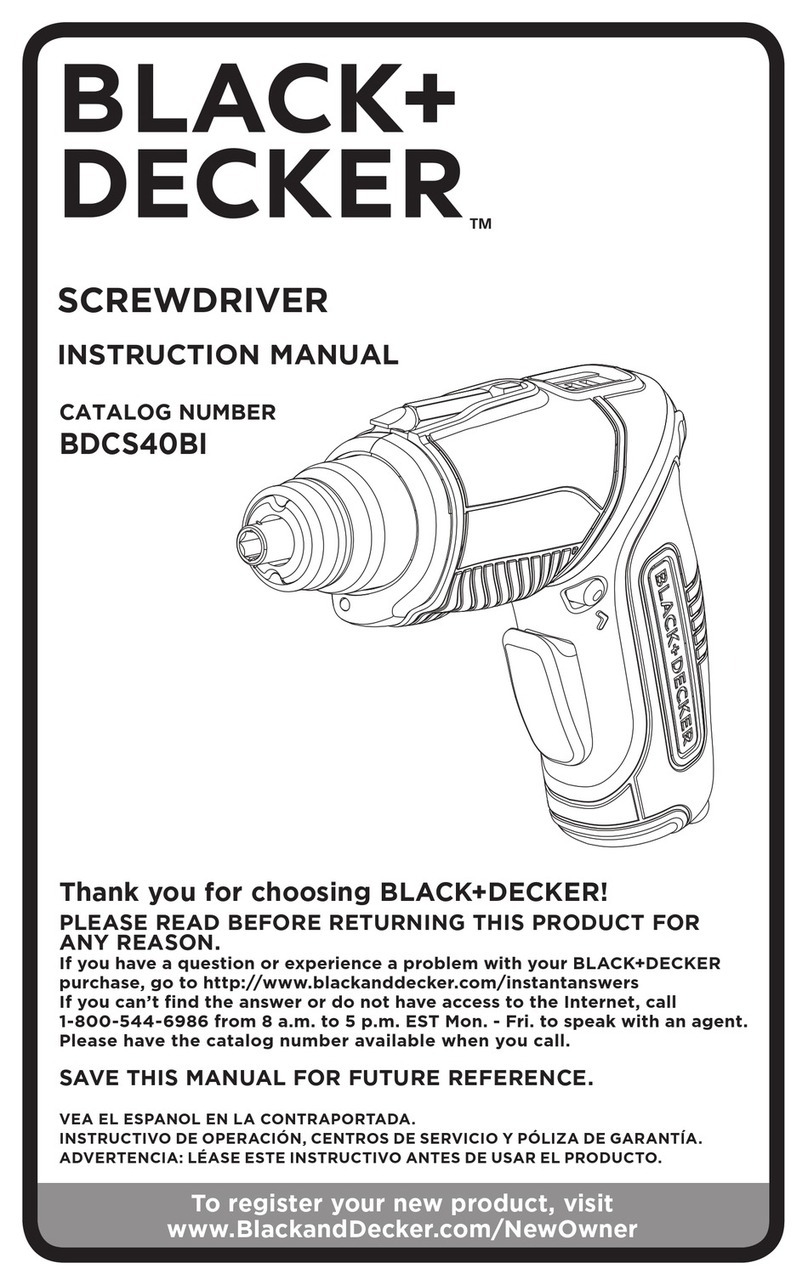
Black & Decker
Black & Decker BDCS40BI instruction manual
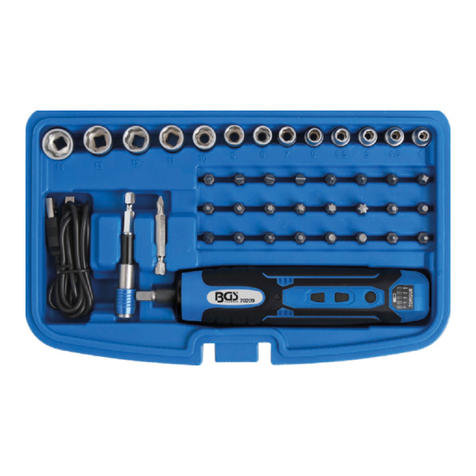
BGS technic
BGS technic 70209 instruction manual
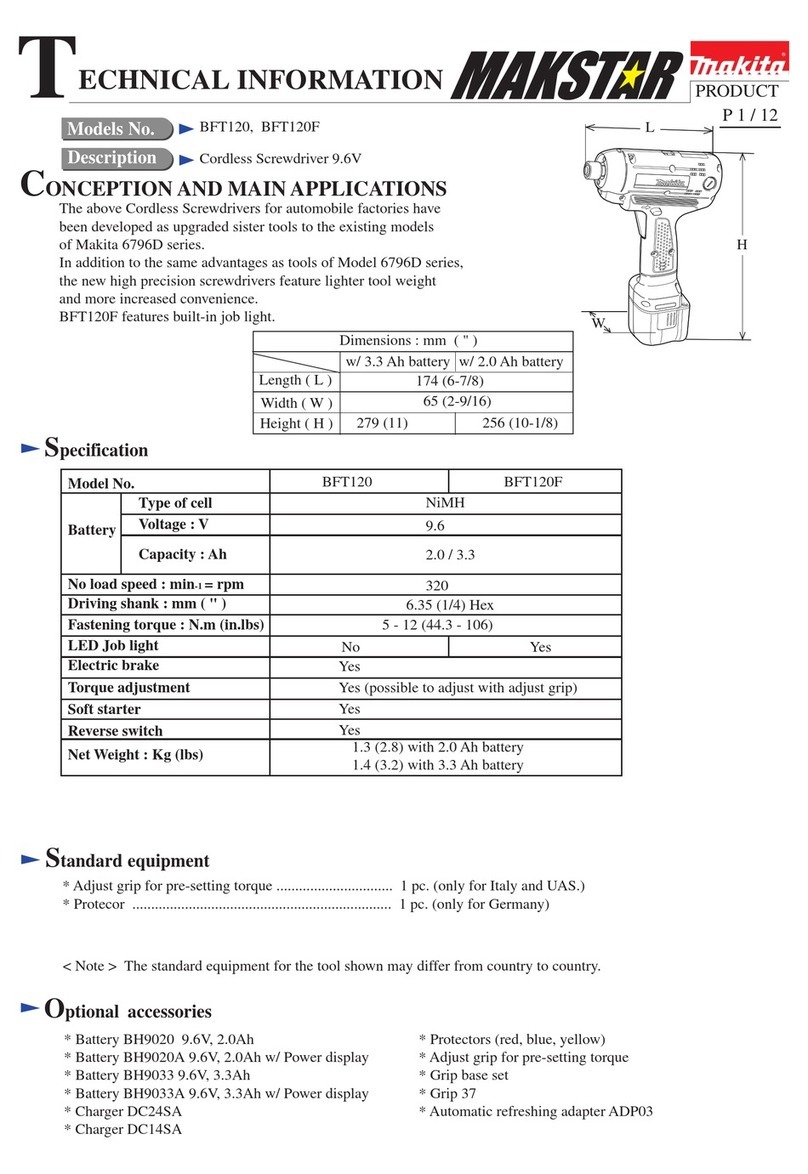
Makita
Makita BFT120F technical information
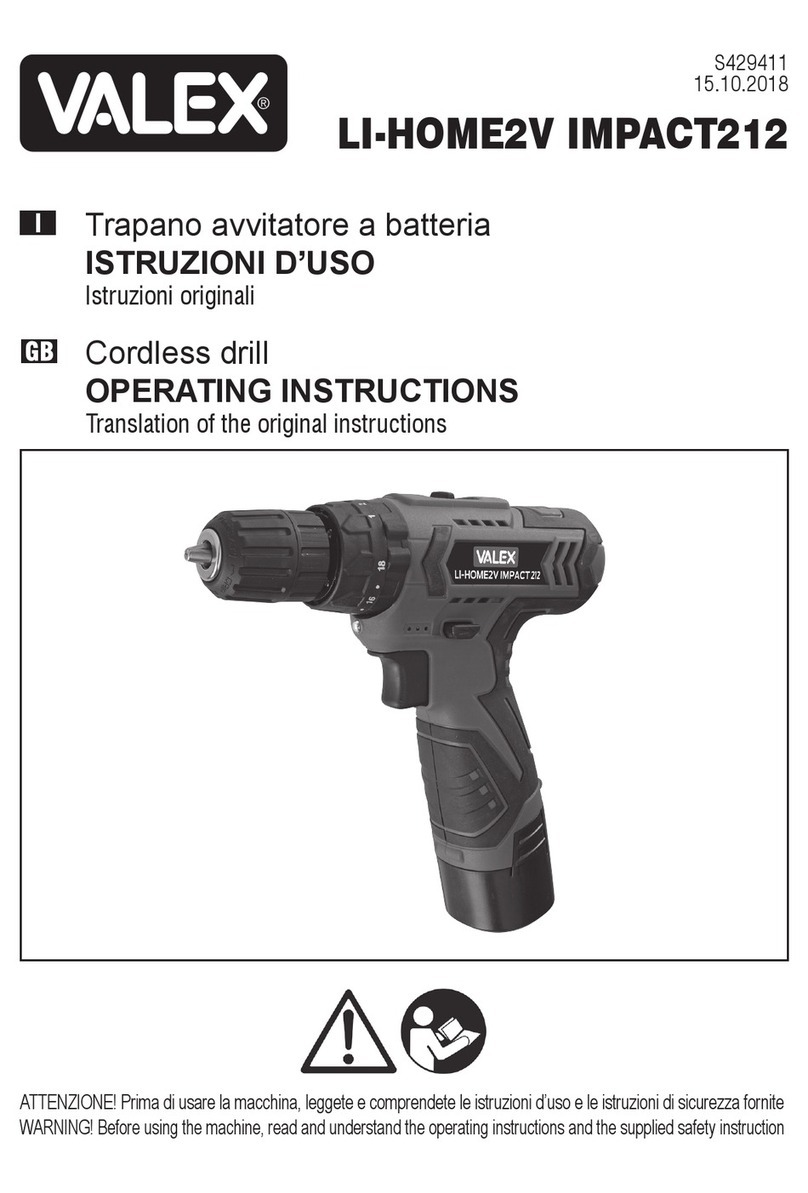
Valex
Valex LI-HOME2V IMPACT212 operating instructions

Hilti
Hilti ST 1800 Original operating instructions
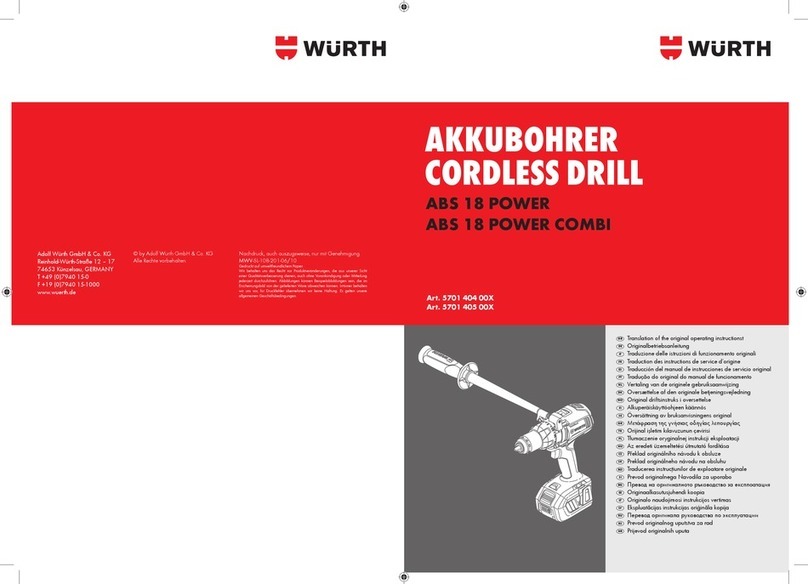
Würth
Würth ABS 18 POWER Translation of the original operating instructions

